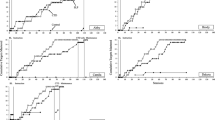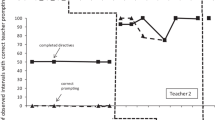Abstract
A high-probability request sequence was implemented with three preschool children with developmental delays within their classroom during typical activities. A multiple baseline design across subjects was used to evaluate the effects of the high-probability request sequence on compliant responding to low-probability requests and the occurrence of disruptive behavior. Results of the study indicate that the use of the high-probability request sequence was effective in increasing compliant responding to low-probability requests delivered by two different trainers for all children. No increases in disruptive behavior were noted as a result of using the high-probability request sequence. When the high-probability request sequence was withdrawn, compliant responding to low-probability requests was maintained for all children across time and in different settings.
Similar content being viewed by others
REFERENCES
Baer, D. M., Wolf, M. M., & Risley, T. R. (1968). Current dimensions of applied behavior analysis. Journal of Applied Behavior Analysis, 1, 91–97.
Breiner, J., & Forehand, R. (1982). Mother-child interactions: A comparison of a clinic-referred developmentally delayed group and two nondelayed groups. Applied Research in Mental Retardation, 3, 175–183.
Bricker, D. D., & Cripe, J. W. (1992). An activity based approach to early intervention. Baltimore, MD: Paul H. Brookes.
Brigance, A. H. (1978). Brigance Diagnostic Inventory of Early Development. Woburn, MA: Curriculum Associates.
Campbell, S. B., March, C. L., Pierce, E. W., Ewing, L. J., & Szumowski, E. K. (1991). Hard-to-manage preschool boys: Family context and the stability of externalizing behavior. Journal of Abnormal Child Psychology, 19(3), 301–318.
Carr, E. G., Newsome, C. D., & Binkoff, J. A. (1976). Stimulus control of self-destructive behavior in a psychotic child. Journal of Abnormal Child Psychology, 4, 139–153.
Carr, E. G., Taylor, J., & Robinson, S. (1991). The effects of severe behavior problems in children on the teaching behavior of adults. Journal of Applied Behavior Analysis, 24, 523–535.
Davis, C. A., Brady, M. P., Hamilton, R., McEvoy, M. A., & Williams, R. E. (1994). Effects of high-probability requests on the social interactions of young children with severe disabilities. Journal of Applied Behavior Analysis, 27, 619–637.
Davis, C. A., Brady, M. P., Williams, R. E., & Hamilton, R. (1992). Effects of high-probability requests on the acquisition and generalization of responses to requests in young children with behavior disorders. Journal of Applied Behavior Analysis, 25, 905–916.
Davis, C. A. & Reichle, J. (1996). Variant and invariant high-probability requests: Increasing appropriate behaviors in children with emotional-behavioral disorders. Journal of Applied Behavior Analysis, 29, 471–482.
Ducharme, J. M., & Worling, D. E. (1994). Behavioral momentum and stimulus fading in the acquisition and maintenance of child compliance in the home. Journal of Applied Behavior Analysis, 27, 639–647.
Evans, L., & Meyer, L. (1990). Toward a science in support of meaningful outcomes: A response to Horner et al. Journal of the Association for Persons with Severe Handicaps, 15, 133–135.
Engelmann, S., & Colvin, G. T. (1983). Generalized compliance training: A direct-instruction program for managing severe behavior problems. Texas: PRO-ED.
Forehand, R. L. (1977). Child noncompliance to parental requests: Behavioral analysis and treatment. In M. Hersen, R. M. Eisley, & P. M. Miller (Eds.), Progress in behavior modification. (Vol. 5, pp. 111–147). New York: Academic Press.
Forehand, R. L., & King, H. E. (1977). Noncompliant children. Behavior Modification, 1, 93–108.
Goldstein, H., Kaczmarek, L., & Hepting, N. (1994). Communication interventions: The challenges of across the day implementation. In R. Gardner, D. Sainato, J. Cooper, T. Heron, W. Heward, J. Eshleman, & T. Grossi (Eds.), Behavior analysis in education: Focus on measurably superior instruction (pp. 101–113). Pacific Grove, CA: Brooks/Cole.
Harchik, A. E., & Putzier, V. S. (1990). The use of high-probability requests to increase compliance with instructions to take medication. Journal of the Association for Persons with Severe Handicaps, 15, 40–43.
Hart, B. M., & Risley, T. R. (1980). In vivo language interventions: Unanticipated general effects. Journal of Applied Behavior Analysis, 13, 407–432.
Horner, R. H., Day, H. M., Sprague, J. R., O'Brien, M., & Heathfield, L. T. (1991). Interspersed requests: A non-aversive procedure for reducing aggression and self-injury during instruction. Journal of Applied Behavior Analysis, 24, 265–278.
Houlihan, D. & Brandon, P. K. (1996). Compliant in a moment: A commentary on Nevin. Journal of Applied Behavior Analysis, 29, 549–555.
Houlihan, D., Jacobson, L., & Brandon, P. K. (1994). Replication of a high-probability request sequence with varied interprompt times in a preschool setting. Journal of Applied Behavior Analysis, 27, 737–738.
Karsh, K. G., Repp, A. C., Dahlquist, C. M., & Munk, D. (1995). In vivo functional assessment and multi-element interventions for problem behaviors of students with disabilities in classroom settings. Journal of Behavioral Education, 5, 189–210.
Kennedy, C. H., Itkonen, T., & Lindquist, K. (1995). Comparing interspersed requests and social comments as antecedents for increasing student compliance. Journal of Applied Behavior Analysis, 28, 97–98.
Losardo, A., & Bricker, D. (1994). Activity-based intervention and direct instruction. A comparison study. American Journal on Mental Retardation, 98, 744–765.
Mace, F. C., & Belfiore, P. (1990). Behavioral momentum in the treatment of escape-motivated stereotypy. Journal of Applied Behavior Analysis, 23, 507–514.
Mace, F.C., Hock, M.L., Lalli, J.S., West, B.J., Belfiore, P., Pinter, E., & Brown, D.K. (1988). Behavioral momentum in the treatment of noncompliance. Journal of Applied Behavior Analysis, 21, 123–141.
Neel, R. S., Jenkins, Z. N., & Meadows, N. (1990). Social problem-solving behaviors and aggression in young children: A descriptive observational study. Behavioral Disorders, 16(1), 39–51.
Patterson, G. R. (1982). Coercive family processes: A social learning approach. Eugene, OR: Castalia Publishing Co.
Sanchez-Fort, M. R., Brady, M. P., & Davis, C. A. (1995). Using high-probability requests to increase low-probability communication behavior in young children with severe disabilities. Education and Training in Mental Retardation and Developmental Disabilities, 30(2), 151–165.
Schopler, E., Reichler, R. J., & Renner, B. R. (1988). The Childhood Autism Rating Scale. Los Angeles, CA: Western Psychological Services.
Singer, G. H. S., Singer, J., & Horner, R. H. (1987). Using pretask requests to increase the probability of compliance for students with severe disabilities. Journal of the Association for Persons with Severe Handicaps, 12, 287–291.
Stokes, T. F., & Baer, D. M. (1977). An implicit technology of generalization. Journal of Applied Behavior Analysis, 10, 349–367.
Stokes, T. F., & Osnes, P. G. (1989). An operant pursuit of generalization. Behavior Therapy, 20, 337–355.
Thorndike, E. L. (1911). Animal intelligence. New York: Macmillan.
Wahler, R., & Dumas, J. (1986). Maintenance factors in coercive mother-child interactions: The compliance predictability hypothesis. Journal of Applied Behavior Analysis, 19, 13–22.
Walker, G. R. (1993). Noncompliant behavior of people with mental retardation. Research in Developmental Disabilities, 14, 87–105.
Yoder, P., Kaiser, A. P., & Alpert, C. L. (1991). An exploratory study of the interaction between language teaching methods and child characteristics. Journal of Speech and Hearing Research, 34, 155–167.
Zarcone, J. R., Iwata, B. A., Hughes, C. E., & Vollmer, T. R. (1993). Momentum versus extinction effects in the treatment of self-injurious escape behavior. Journal of Applied Behavior Analysis, 26, 135–136.
Zarcone, J. R., Iwata, B. A., Mazaleski, J. L., & Smith, R. G. (1994). Momentum and extinction effects on self-injurious escape behavior and noncompliance. Journal of Applied Behavior Analysis, 27, 649–658.
Author information
Authors and Affiliations
Rights and permissions
About this article
Cite this article
Killu, K., Sainato, D.M., Davis, C.A. et al. Effects of High-Probability Request Sequences on Preschoolers' Compliance and Disruptive Behavior. Journal of Behavioral Education 8, 347–368 (1998). https://doi.org/10.1023/A:1022875331474
Issue Date:
DOI: https://doi.org/10.1023/A:1022875331474




